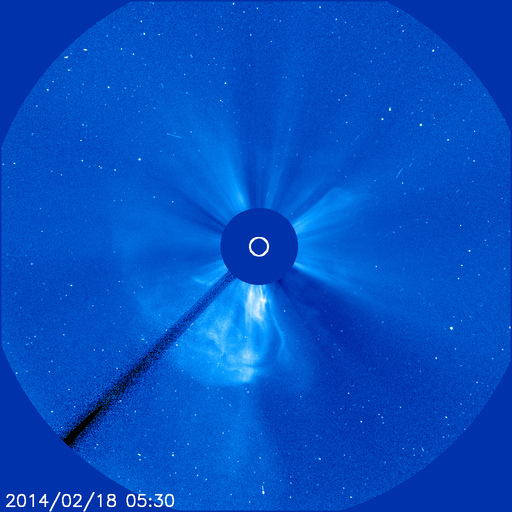Space Weather Alert - 20 February 2014
What Has Happened?
A series of coronal mass ejections (CMEs) have left the Sun this week, so an increase in geomagnetic activity is expected over the next few days.
Two CMEs have already arrived in the early hours of yesterday (19th) and today (20th), causing geomagnetic activity to reach storm conditions.
Three further CMEs have been observed leaving the Sun. Two associated with filament eruptions on 18th and 19th Feb, and one associated with a C-class X-ray solar flare early this morning. These CMEs are likely to interact and are expected to hit the Earth with at least a glancing blow during the next few days. Given the already increased level of geomagnetic activity, storm conditions are anticipated following the arrival of the first of these CMEs, expected late tonight. Further periods of storm conditions are possible for the next few days.
Assuming clear dark skies, there is an increased chance of seeing the aurora in the hours following the arrival of the CMEs, particularly at high latitudes in the North of Scotland.
Sign-up to receive Geomagnetic Disturbance Alert emails.
Follow us on Twitter:
Follow @BGSauroraAlert for more occasional aurora alerts.
Follow @BGSspaceWeather for daily space weather forecasts.
Glossary
- BGS
- The British Geological Survey is one of the Natural Environment Research Council's Research Centres.
CME or Coronal Mass Ejection- The eruption of a portion of the outer atmosphere of the Sun into space, caused by rapid changes in its magnetic field. Often occurs along with a solar flare.
- Filament Eruption
- An eruption of solar plasma (i.e. ions and electrons) associated with the upward movement of solar magnetic field lines into the corona. Filaments are usually dark against the bright solar disk but can appear bright (as 'erupting prominences') on the limbs of the Sun against the darkness of space. Filaments are often associated with CMEs.
- Solar Flare
- Energy released by the explosive reorganisation of magnetic fields within the Sun's atmosphere.
Solar Wind- The ever-present expansion of the Sun’s hot outer atmosphere into the solar system, which carries space weather within it.
Sunspot- A region of intense magnetic field in the Sun's visible outer atmosphere often associated with flares and CMEs.



